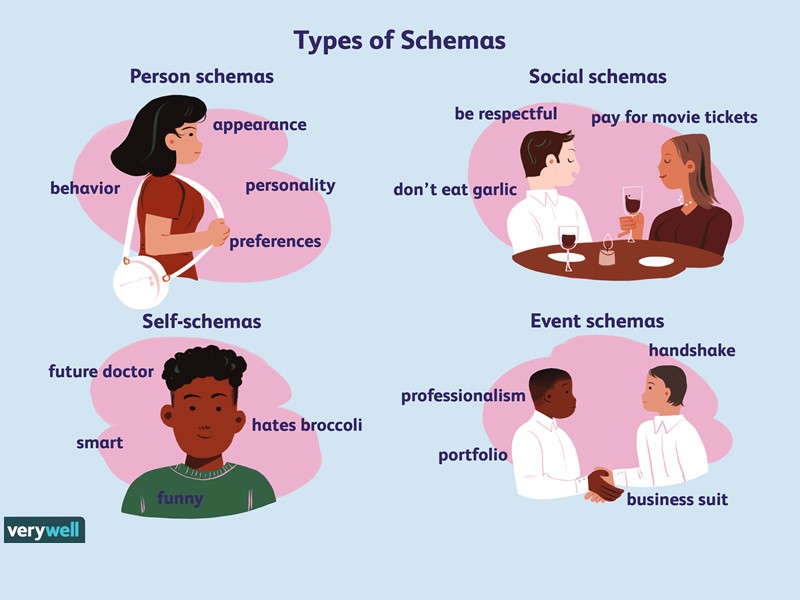Insight Blog
Agility’s perspectives on transforming the employee's experience throughout remote transformation using connected enterprise tools.
15 minutes reading time
(3086 words)
A Brief Primer On AI & Schemata In Communication (2024)
Explore how schemata in communication shape understanding, enhance interactions, and influence cross-cultural exchanges.
Schemata in communication play a pivotal role in shaping how we interpret and respond to information, acting as mental frameworks that organize past experiences and knowledge. With the rapid advancement of artificial intelligence (AI), understanding and integrating schemata can significantly enhance how AI systems interact with humans.
This article delves into the dynamic relationship between AI and communication schemata, exploring how AI can leverage these conceptual frameworks to improve clarity, effectiveness, and personalization in interactions. The ability of AI to adapt based on schemata is transformative, as it bridges the gap between rigid programming and intuitive human responses. This approach not only enhances user experience but also sets the stage for AI to evolve alongside human communication trends. says Mike Cedric of Holsper.By examining this integration, we will uncover the potential of AI to not only understand human communication patterns better but also to respond in ways that are increasingly natural and contextually appropriate.
History of schemata
Schema theory wasn't the brainchild of a single psychologist; rather, it emerged through the collective efforts of various contributors. Among these luminaries, Bartlett stands out for exploring the relationship between schemas and procedural memory. He posited that our past experiences serve as a lens through which we perceive and make sense of new experiences, shaping our expectations and assumptions.
Jean Piaget, renowned for his cognitive development theory, placed schemas at the core of his framework. Piaget coined the term 'schema,' which gained widespread recognition through his work.
His theory suggested that new information can assimilate into existing schemas or trigger cognitive dissonance if it contradicts them, prompting a reevaluation or expansion of our mental structures. Piaget identified three primary drivers of cognitive development: biological maturation, interaction with the environment, and social engagement.
In a seminal experiment, Brewer and Terens shed light on the workings of schemas. They tasked participants with waiting in an office for half a minute before questioning them about their surroundings. Surprisingly, many participants reported seeing items like books that were absent from the actual office setup.
This phenomenon can be attributed to the participants' schemas, which influenced their perceptions based on their preconceived notions of what constitutes an office environment.
AI & Schemata In Communication - A Complete Guide
Characteristics Of Schema
- Schemas exhibit a remarkable capacity for adaptation and growth, evolving in response to newfound knowledge and experiences. This developmental plasticity underscores their significance in cognitive processes.
- Significantly, schemas play a pivotal role as invaluable tools for assimilating and interpreting novel information. Their profound influence on our comprehension cannot be overstated.
- Moreover, schemas possess the unique ability to encapsulate both declarative and procedural knowledge. Declarative information encompasses consciously retained facts, such as historical dates—a hallmark of explicit memory.
- Conversely, procedural information pertains to practical know-how, often conveyed through action rather than language. Skills like walking, driving, or running exemplify this form of implicit memory.
- Each harbors a personalized schema shaped by their unique life journey. For instance, a seasoned sweater knitter boasts a richly detailed schema for knitting, contrasting sharply with that of a novice.
What is Schemata in Communication?
So, what is Schemata in communication? Schemata in communication refer to cognitive structures that individuals use to organize and interpret incoming information based on their prior knowledge and experiences.
These mental frameworks help people make sense of complex information quickly and efficiently by fitting new experiences into pre-existing categories. Schemata encompass a range of knowledge, from simple expectations about everyday events to more complex theories about how the world works.
In communication, schemata influence how messages are decoded, understood, and responded to, guiding both speaker and listener in navigating the exchange of ideas and information.
Enhancing AI Understanding with Schemata
AI systems equipped with schemata can achieve a more nuanced understanding of language and context, crucial for effective communication. For instance, by applying event schemata, AI can recognize the typical sequence of actions in common situations and anticipate what comes next, improving its predictive capabilities.
Role-schemata allow AI to understand different social roles and the expectations associated with them, enabling more tailored interactions based on whether it is communicating with a manager, a customer, or a peer. This application of schemata makes AI interactions seem more natural and context-aware, significantly enhancing user experience.
Improving Interactions Across Platforms
Integrating schemata into AI also enhances its functionality across various communication platforms, from chatbots on websites to virtual assistants in smartphones. By utilizing self-schemata, AI can personalize interactions by learning user preferences and behavioral patterns, thus offering recommendations and solutions that are more aligned with individual needs.
In customer service, AI can use schemata to handle inquiries more efficiently, predicting customer issues and providing solutions faster.
This not only improves the speed of service but also ensures a higher degree of accuracy and personalization in responses, leading to better customer satisfaction and engagement.
Examples of Schemata in Communication
Follow us and access great exclusive content everyday: Follow us on Google News
Everyday Conversations
One of the most relatable examples of schemata in communication occurs in everyday conversations about routine activities. For instance, when someone mentions they went to a wedding, the "wedding" schema is activated, which includes expectations of a ceremony, reception, bride, groom, and celebration.
This schema helps individuals fill in gaps in communication without needing every detail explicitly stated, allowing for smoother and more efficient conversations. This example demonstrates how schemata enable us to make assumptions and predictions based on typical patterns, enhancing our ability to communicate quickly and effectively about common experiences.
Schemata thus facilitate quicker understanding and assimilation of information, reducing the cognitive load during social interactions and allowing us to focus on the emotional and relational aspects of communication.
Marketing and Advertising
In marketing and advertising, schemata are strategically used to connect with target audiences by tapping into common cultural or social schemata. For example, a commercial that depicts a family gathering around the dinner table for a meal taps into the "family dinner" schema, which resonates with viewers' understanding of family, togetherness, and home-cooked meals.
This not only helps convey the message quickly but also evokes emotional responses that can influence consumer behavior and brand loyalty. Such applications show how schemata can be employed to create powerful narratives that speak directly to shared experiences and values.
By leveraging these deeply ingrained schemata, marketers can create ads that are more memorable and effective, fostering a connection that goes beyond the superficial and reaches into the shared collective memory and experience of their audience.
Cross-Cultural Communication
Schemata also play a critical role in cross-cultural communication, where differing schemata can lead to misunderstandings. For example, the concept of personal space varies widely between cultures. In cultures where close physical proximity is normal, such as in many Latin American cultures, the personal space schema includes closer interactions.
Conversely, in cultures like the United States, more distance is expected. Misunderstandings arise when individuals interpret the proximity of others through the lens of their own cultural schemata. Recognizing these differences is crucial for effective communication and avoiding cultural faux pas, illustrating the need for awareness and adaptation in international interactions.
This understanding helps in developing a more nuanced approach to cross-cultural communication, enabling individuals and businesses to foster better relationships and smoother interactions across cultural boundaries.
Types of Schemata in Communication
You may also like: Best Apps for Employees: UPDATED 2022 – A Complete Guide
Self-Schemata
Types of Schemata in communication begin with self-schemata, which refer to the cognitive structures individuals use to organize information about themselves. This type of schema affects how people interpret messages and interactions in ways that are consistent with their self-identity.
For instance, a person with a strong self-schema as an environmentalist may pay more attention to and engage more deeply with communications about sustainability and environmental issues.
This selective attention and interpretation based on self-schemata help individuals maintain a consistent sense of self, influencing both how they communicate their identity and how they interpret information related to that identity.
Role-Schemata
Role-schemata are another crucial type that organizes information based on the social roles individuals assume, such as parent, teacher, or manager.
These schemata guide expectations and behaviors in specific contexts, facilitating appropriate communication within defined roles. For example, a manager's role-schema includes expectations for leadership and decision-making, which influences how they communicate with team members and what communication they prioritize.
Understanding and aligning with role-schemata in communication can greatly enhance effectiveness, as it ensures that messages are tailored to fit the expected norms and behaviors of the roles involved.
Event-Schemata
Event-schemata, often referred to as scripts, organize information about sequences of actions that are expected in particular situations.
These schemata are essential for predicting what will happen next in a familiar context, allowing for efficient processing and appropriate responses. For instance, the event-schema for a job interview includes a greeting, self-introduction, question and answer exchanges, and a closing, guiding both interviewer and interviewee in their interactions.
Event-schemata streamline communication by setting a predictable pattern that individuals can follow, reducing uncertainty and improving the smoothness of exchanges in routine or structured situations.
Event Schemas
Schemas outline the expected behavior or actions for individuals in particular contexts or situations. For example, they dictate how one should behave during a lecture or while waiting in line for tickets. These event schemas are commonly referred to as scripts, detailing the steps involved in various activities.
Object Schemas
These schemas center around material objects and their functionalities. For instance, defining a car as a mode of transportation for traveling from one location to another constitutes a schema for a car—an object.
Understanding Schemata Driven Communication
Enhancing Communication Strategies
Schemata driven communication significantly improves how messages are crafted and delivered, making interactions more effective and resonant.
By understanding the schemata that individuals commonly use, communicators can tailor their messages to align with the audience's expectations and mental models. For instance, a health campaign designed to educate the public about flu prevention might use the event-schema for illness (symptoms, diagnosis, treatment) to structure its messages, ensuring that the information is organized in a way that the audience finds logical and easy to comprehend.
This alignment not only facilitates quicker understanding but also enhances retention of information.
Benefits in Personalized Messaging
Incorporating schemata-driven approaches allows for more personalized and impactful communication, particularly in marketing and customer relations. By utilizing self-schemata and role-schemata, companies can customize their interactions based on the specific characteristics and roles of their audience.
For example, an email marketing campaign might segment its audience into different consumer roles and tailor messages that speak directly to the needs and expectations of each segment, such as price-sensitive shoppers versus quality-focused consumers.
This targeted communication strategy increases the relevance of the messages, leading to higher engagement and conversion rates.
Application in AI Interaction and Engagement
Schemata driven communication is also extremely beneficial in enhancing AI applications for better interaction and engagement.
AI systems that can identify and adapt to the user's schemata can offer more accurate and contextually appropriate responses. For instance, an AI-driven customer service chatbot that recognizes a customer's frustration schema (expressed through specific keywords or sentiment analysis) can switch to a more empathetic communication style, addressing the customer's concerns more effectively.
Additionally, AI systems equipped with an understanding of cultural schemata can avoid miscommunications and adapt interactions to fit cultural norms and expectations, significantly improving user satisfaction and fostering smoother, more effective exchanges across diverse user bases.
What is an example of a schema
A schema is a cognitive framework or concept that helps organize and interpret information. One classic example of a schema is the "restaurant schema." This schema includes a set of expectations and knowledge about what typically happens when one visits a restaurant. For instance, you might expect to be greeted by a host, shown to a table, handed a menu, given time to order, served food, and presented with a bill. This schema allows individuals to navigate the dining experience efficiently and understand their roles and the roles of others in this setting without needing explicit instructions each time.
Examples of schemata in communication include the "classroom schema." This schema encompasses expectations about the physical layout (such as desks, a blackboard, and a teacher's desk), the behavior of individuals (students listening, teachers instructing), and the sequence of activities (lectures, discussions, assignments). When students enter a classroom, their schema helps them understand the context and what is expected of them, facilitating a smoother learning process.
Another example of schemata in communication is the "doctor's visit schema." This schema includes expectations such as checking in at the reception, waiting in the lobby, being called into an examination room, explaining symptoms to the doctor, undergoing an examination, receiving a diagnosis, and discussing treatment options. This schema helps patients and healthcare providers efficiently manage the interaction and understand each other's roles and actions without detailed explanations.
Schemas like these are crucial because they help people quickly make sense of their experiences by linking new information to existing knowledge frameworks.
A schema is a cognitive framework or concept that helps organize and interpret information. Here are five examples of schemata in communication:
- Restaurant Schema: This schema includes a set of expectations about what typically happens when visiting a restaurant. You might expect to be greeted by a host, shown to a table, handed a menu, given time to order, served food, and finally presented with a bill.
- Classroom Schema: This schema encompasses expectations about the physical layout (desks, a blackboard, and a teacher's desk), the behavior of individuals (students listening, teachers instructing), and the sequence of activities (lectures, discussions, assignments).
- Doctor's Visit Schema: This schema involves the sequence of events during a medical appointment, such as checking in at reception, waiting, being called into an examination room, explaining symptoms to the doctor, undergoing an examination, receiving a diagnosis, and discussing treatment options.
- Airport Schema: This schema includes the steps and expectations involved in air travel, such as checking in, passing through security, waiting at the gate, boarding the plane, finding your seat, and following in-flight procedures.
- Job Interview Schema: This schema covers the typical structure of a job interview, including arriving on time, greeting the interviewer, answering questions about your background and qualifications, asking questions about the company, and discussing next steps in the hiring process.
- Examples of schemata in communication psychology: In communication psychology, schemata are essential cognitive frameworks that shape our understanding and interpretation of interactions. For instance, event schemata, or scripts, guide our expectations and behaviors in specific situations, such as knowing the sequence of actions when dining at a restaurant—from being greeted by the host to paying the bill. Role schemata influence our perceptions and interactions based on social roles; for example, we expect teachers to be authoritative and knowledgeable. Self-schemata affect how we see ourselves and communicate; a person who views themselves as shy might avoid initiating conversations. Person schemata help us form impressions and expectations about others; if we believe a friend should be supportive and trustworthy, we use this schema to evaluate our relationships. These cognitive structures streamline communication by providing a basis for understanding and predicting social interactions.
What is the difference between schemata and schema?
The terms "schema" and "schemata" refer to the same concept in cognitive psychology but differ in their grammatical number. "Schema" is the singular form, while "schemata" is the plural form.
A schema refers to a single cognitive framework or structure that helps an individual organize and interpret information. For example, a "birthday party schema" might include knowledge about typical activities (like singing "Happy Birthday," eating cake, and opening presents) and expected behaviors at a birthday celebration.
On the other hand, schemata encompass multiple such cognitive frameworks. For instance, a person might have various schemata related to different social events, such as weddings, funerals, and business meetings. Each of these schemata provides a structured understanding of the typical sequences and elements involved in these distinct contexts.
Therefore, "schemata" is used when referring to multiple schemas that help individuals navigate various experiences and situations.
Challenges of Schemas
While schemas typically facilitate learning effortlessly, there are instances where preexisting schemas impede the absorption of new information. Prejudice is a prime example, distorting individuals' perception of reality and impeding their receptiveness to fresh insights.
Take, for instance, the impact of gender expectations and stereotypes. Embedded within every culture are schemas dictating what constitutes masculine and feminine traits. These schemas often create stereotypes regarding the behaviors and roles expected of men and women.
In a notable study, researchers presented children with images aligning with or contradicting gender expectations. Some viewed images consistent with stereotypes (e.g., a man working on a car, a woman washing dishes), while others were exposed to gender-inconsistent depictions (e.g., a man washing dishes, a woman fixing a car).
Subsequent recollection assessments revealed a fascinating trend: children with rigidly stereotypical views of gender were more prone to altering the gender of individuals depicted in the gender-inconsistent images. For instance, if presented with an image of a man washing dishes, they were inclined to recall it as describing a woman engaged in the same activity.
This underscores the profound influence of schemas on perception and memory, highlighting the pervasive nature of gender stereotypes in shaping cognitive processes.
Free ebook: How To Get Your Intranet Off The Ground
Wrapping up
Enter your text he Understanding schemata in communication is essential for crafting effective and engaging interactions across various contexts. By recognizing and utilizing these cognitive frameworks, communicators and AI developers can significantly enhance the clarity and impact of their messages.
Whether through personalized marketing, structured information delivery, or AI-driven interactions, schemata-driven approaches optimize communication strategies, ensuring that they resonate well with diverse audiences.
As we continue to delve deeper into the complexities of human cognition and communication, the strategic application of schemata stands out as a critical tool for success in our increasingly interconnected world. re ...
Categories
Blog
(2610)
Business Management
(323)
Employee Engagement
(212)
Digital Transformation
(174)
Growth
(119)
Intranets
(112)
Remote Work
(61)
Sales
(48)
Collaboration
(36)
Project management
(29)
Culture
(28)
Customer Experience
(26)
Knowledge Management
(21)
Leadership
(20)
Comparisons
(6)
News
(1)
Ready to learn more? 👍
One platform to optimize, manage and track all of your teams. Your new digital workplace is a click away. 🚀
Free for 14 days, no credit card required.
















